Gorgon’s Genestealer Cult, or How I Learned to Embrace My Alien Masters
INTRODUCTION
After I won Best Appearance at the 2008 Baltimore GT for my Genestealer Cult army, there was some interest here and elsewhere in a writeup of how I built the thing. So here it is.
First, I'll talk about the thinking and planning involved, then I'll go over the miniatures, unit-by-unit. One thing that surprised me at the GT is how few players knew anything about Genestealer Cults (making me feeling very old). So I'll also give some brief GCult background points along the way.
THE PLAN
A seed is (im-)planted
I had the idea for this army about six or seven years ago. After a few years painting Tyranids, I wanted to do something different. I always loved the Genestealer Cult background, and had a brainstorm that I should build a small GCult, maybe 500 points worth. After a steal on Bartertown and a timely bitz-by-weight purchase, I ended up with a LOT of models. And suddenly, a 1500 or 1750 point army was doable. Cults have a way of growing, I guess.
With all those models in my greedy clutches, I had to figure out what army's rules to use. To properly represent a GCult, I knew I needed an army with a combination of tough close combat troops, vehicles, powerful commanders and cheap militia. I saw two candidates -- Orks, and Lost and the Damned. After playing around with both, I fell in love with the LatD list.
Curves in the road
After some false starts and some intervening army projects, I finally started serious work on the GCult in late 2006, intending to field it at the 2007 Baltimore GT. LatD were a legal GT army that season...until they were declared illegal midway through...only to be declared legal again before the end of the season. :P Argh. With all the stops and starts, it didn't happen in time.
I'd just have to roll with the punches and rework the army around the new Ork codex. Muah-ha-ha.
HOW many models?
The catch with the Ork codex is that it increased the number of models I needed. Instead of painting up 40-50 Hybrids to serve as Mutants, suddenly I needed around 80 to serve as various types of Boyz.
In addition, I needed some additional units and vehicles I hadn't counted on, and had to rework others. Yikes. Considering my life was more complicated now with a wife, house and baby, I knew I was going to be painting right up to the GT.
So I planned out each month's painting, doing basic stuff I knew I needed first and saving more variable items for the later months. I wasn't going to get many games in before the GT, and wasn't really trying to field anything resembling an "optimized" army. But I wanted to allow for some last-minute list tinkering.
THE ARMY
She comes in colors
I'm not a fan of the traditional blue-purple GCult scheme. It has a knack for looking garish by current edition standards, in my opinion. So I decided to use a basically monochromatic scheme. I'd use a neutral (khaki) and a dark blue as my base hues. Hybrid and Purestrain armor/central carapaces would be dark blue, while khaki would be the primary color on robes and elsewhere. As a nod to the original color scheme, I'd pick out certain small details here and there in purple, being careful not to overwhelm my main colors.
Here are the painting specifics. For the khaki, I used VGC Khaki. Those areas received a basecoat of a mix of Khaki and a small amount of Plague Brown, then a main coat of Khaki, Khaki/VGC Skull White highlights, and then a thin glaze of Khaki. It's only three layers, but the glaze helps make it look like a more complex blend. When painting a large army, a key part of planning is figuring out how to get a good effect at a reasonable time investment.
The dark blue areas received a basecoat of VMC Dark Prussian Blue and VGC Black, then a highlight of Dark Prussian Blue/VMC Prussian Blue, a highlight of Prussian Blue and VMC Pale Blue, spot highlights of Pale Blue, and a glaze of Dark Prussian Blue.
I used a mix of play sand and fine talus on the bases, and painted them using Plague Brown. I added cork on the bases of some character models to add interest, and used bits of Woodland Scenics dark green clump foilage on selected bases throughout the army. I'll get into more details in each unit entry below.
Blah, blah, blah. Enough talk. Here's the army as it looked on the display base at the GT.
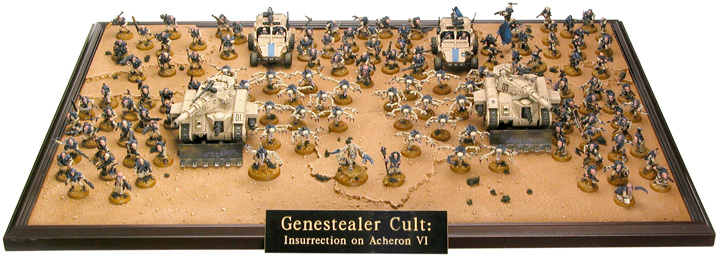
The background
The army represents an uprising on the backwater, dusty world of Acheron VI. While the planet is settled thanks to its valuable mineral deposits, life is difficult due to the rocky, sandy soil, poor growing season and mildly toxic atmosphere. Most of the population lives in or just outside the only two significant cities on the planet. The remainder of the population lives out in the wilderness in nomadic, tribal communities.
The infestation began years ago when a chunk of space hulk impacted the planet's surface. Representatives of a local tribe investigated the site, encountered a type of alien creature they'd never seen before, and returned to their camp carrying a few more chromosomes than they left with.
The rest of the tribe was quickly implanted, and the infestation slowly spread to other tribes as they encountered one another. Because of the tribes' isolation, the few Imperial officials on the planet were unaware of the cult's existence and growth over the years. Soon, the tribes were filled with horrific Genestealer-human hybrids, growing more humanlike in appearance with every new generation. Finally -- as is the norm in GCults -- the most humanlike hybrids gave birth to a generation of full, purestrain Genestealers. And that signaled the cult to make its move.
We can only imagine what went through the minds of the Imperial officials on Acheron VI when they saw vast mobs of humans, aliens and bizarre human-alien hybrids pour out of the wastes and lay siege to their weakly-defended cities.
HQ: Genestealer Patriarch and Magus
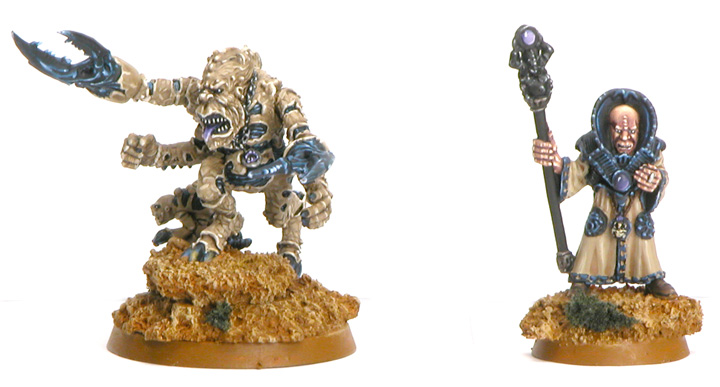
A Genestealer Cult's Patriarch represents the Purestrain Genestealer that began the infestation, now grown bloated and monstrous. The Patriarch is the spiritual leader of the cult, as well as its most deadly member. Over time, the Patriarch grows stronger psychically, until it becomes a psychic beacon that leads Tyranid Hive Fleets to its planet. The Patriarch fit nicely as a Warboss.
The Magus is a nearly-human hybrid possessed of deadly psychic powers. The Magus serves as a charismatic second-in-command in a Genestealer Cult, interpreting and voicing the desires of the Patriarch. In my GT army, it served as a Big Mek (with the kustom force field representing his psychic shielding of his minions). But I've also fielded it as a Weirdboy.
The Patriarch model is fairly hunched over, and smaller than you'd expect. To give it more height and show off more detail, I positioned it on a slight incline built of cork. I also added a Genestealer familiar on the base to serve as its attack squig. The Patriarch's stock claws are also surprisingly weedy, so I cut them off and replaced them with crab-style claws from the Chaos Possessed set.
The Magus model is unconverted, although it's one of the relatively rare variants. I picked this variant because of its superior details to the familiar, left-handed staff pose.
Elites: Broodlord and Purestrain Genestealers

You can’t have a Genestealer Cult without Purestrains. But I was unsure at first how to fit them into an Ork army. Then it occurred to me -- Genestealers can be infiltrators, so why not Kommandos?
Since little conversion was required, the Purestrains were probably the most straightforward painting and modeling job. The miniatures are both of the multipart variety and the simple Macragge poses. As you can see, the Macragge models blend in without a hitch.
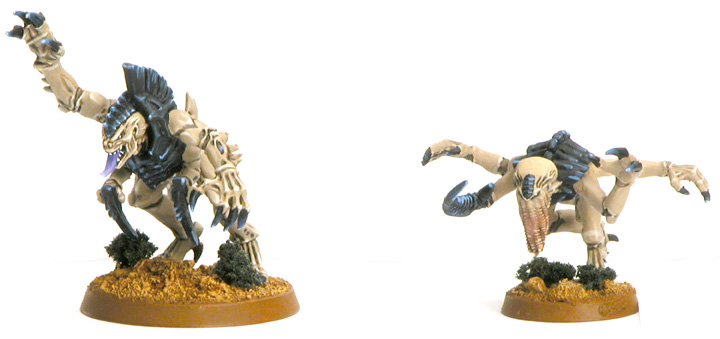
Although a new addition to Tyranids and not traditionally a part of Genestealer Cults, I thought the Broodlord should be included in my army. It’s important to note that Broodlords are a different animal than Patriarchs. While they both represent advanced forms of Purestrain Genestealers, Patriarchs are venerated, spiritual leaders for the cult, while Broodlords are pure combat commanders. The old fluff indicates that another Purestrain would take the place of the Patriarch in the event of its death. It’s now reasonable to assume said ascension would come from among the cult’s Broodlords.
Since I’d determined that my Purestrains would be Kommandos, the Broodlord naturally represented another master infiltrator -- the feared Snikrot.
I had two units of Kommandos, so the other unit was led by a Purestrain Acolyte of sorts, distinguished by its feeder tendril head and its great chitinous claw. The claw is from the Daemonette box, and represents a power klaw.
Elites: Genestealer Hybrid Heavy Weaponers


Hybrids have long been a heavy weapons platform for Genestealer Cults, so it seemed appropriate to include some and count them as Lootas. I went with a mix of heavy weapons to represent the random Deffguns. I used a few bits from the very old Chaos/GCult heavy weapons sprues, along with Space Marine Scout heavy bolters and Steel Legion missile launchers (for that RPG look). Going forward, the RPGs will likely be phased out of this unit (and into a unit of Tankbustas) and replaced by more of the old Chaos weapons as I obtain them.
I'll get into how I did the flesh in the main Hybrids entry below.
Troops: Genestealer Hybrids



The bulk of my army are Genestealer Hybrids, counting as Ork Boyz. Genestealer Hybrids are the horrific offspring of lifeforms implanted with Genestealer geneseed. With each new generation, Hybrids show more resemblance to their parent lifeform, until they’re virtually indistinguishable from the original. With humans, this process usually takes around four generations. In the case of Eldar, it can take many more.
In my army, you can see examples of more upright, human-looking Hybrids, and hunched-over uglies with extra arms. Rather than separate models based on their generation, I decided to mix them together in units – mainly because I like the shambling, motley look that creates.
I fielded two large units of Hybrids with firearms – counting as shootas – and one large unit armed with close combat weapons and pistols – counting as choppas and sluggas. The top row of Hybrids are mostly from my "shootas," while the second and third rows are from among my "sluggas."
The two metal Hybrid poses most familiar to gamers are probably the two classic one-piece models sculpted by Jes Goodwin. I had a lot of both poses in my stockpile. In order to break them up a bit within the units, I did some minor weapon swaps that you can see in the above photos. Sometimes minor conversions are all you need to create some variety.
Another interesting modeling point is that the plastic Genestealer arms *aren’t* the proper arms for the metal, armless Hybrids, even if that’s what GW gave away with the models in later years. They’re actually a lousy fit. The metal Hybrids were originally intended to use the old IG plastic arms. However, as I only had a couple sprues of the IG arms, I modified the Genestealer arms by cutting off the shoulder areas to get a smaller mount area and a better fit.
My formula for flesh varied throughout the painting process. For the most recent batch, I did a basecoat of GW Foundation Tallarn Flesh, followed by highlights with VMC Beige Red. Next, I did a wash of a mix of GW Leviathan Purple and Ogryn Flesh for shading. Then I re-highlighted with Beige Red and VMC Flesh Tone, did some selected highlights with mixes of Flesh Tone and VMC Light Flesh, and finished with a very thin glaze of Beige Red to pull it all together.
Like I said, the formula varied. That’s why there are some slight flesh tone differences throughout the Hybrids – something that I think worked out rather well.
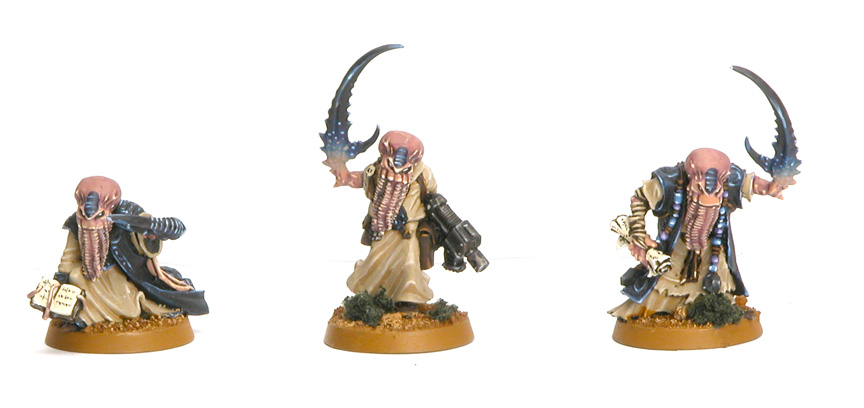
Here are the Acolytes that lead the three Hybrid units. I like to think of them as the apostles of the Magus. They count as Nobs. The models are converted from an Imperial Preacher, a Chaos Sorceror and a Dark Emissary. I gave them feeder tendril heads to make them stand out, even if they’re a relatively new invention and not part of Genestealer Cult canon. The claws are from the Daemonette plastic set and count as power klaws.
Troops: Brood Brothers


Brood Brothers are the implanted parents and siblings of Genestealer Hybrids. After being implanted with the geneseed, the host organism’s DNA is reprogrammed to produce Hybrid children. What’s more, they become enslaved to be fiercely protective of their horrific children and the rest of the cult.
Since Brood Brothers are mostly untrained militia and a cannon fodder unit, it made sense to count them as Gretchin. The models are mostly unconverted Ash Waste Gangers. I like their dusters and how their respirators illustrate the poor atmosphere on Acheron VI.
The Genestealer Hybrid with the whip counts as the unit's Runtherd. I'm going to replace that whip with something more menacing in my next phase for the army.
Fast Attack: Buggies
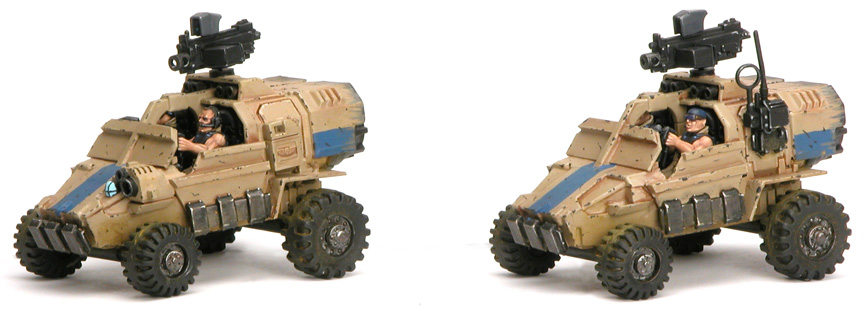
Here are the buggies I constructed out of a pair of old Space Marine landspeeders. I removed the fins and other details, then built up an undercarriage, axles and other areas using plasticard and plastic rod. I'm no expert with plasticard, but a conversion as straightforward as this is actually really easy and something anyone can do.
The drivers are Sentinel drivers and IG gunner bits. The heavy bolters represent big shootas. The Tau targeters I added on top represents their twin-linked status. The guns are removable, and I'll work up rokkits and skorchas options in the next phase of the army.
I'll get into the painting, chipping and weathering in the section about the Russes below.
Heavy Support: Liberated Leman Russes


These are my two Leman Russ tanks that the cult has liberated and put to use against the Imperial government.
At the GT, the Russes counted as Battlewagons armed with kannons and 4 big shootas. I felt the Battlewagon AV was better fit to rep a Russ. Ultimately, they ended up hard to kill but no real threat in my games. Oh well, at least they looked good. The sponsons are magnetized and removable in case I want to field them as looted wagons with boomguns.
The tank commander is a FW Tallarn piece, and both turrets are FW Krieg Ryza patterns. I felt they had both a grittier and more archaic look to them that'd fit PDF tanks from a backwater planet.
Painting them was quite an education. The other two armies I've spent most of my time on this decade are my Tyranids and my Vampire Counts. In other words, it's been close to 10 years since I've painted a tank. Initially, I started out painting them like I would any other miniatures, and they just didn't look right. I quickly realized I needed to use a subtler approach than I would with infantry models, which tend to need exaggerated shading and highlights.
So I reapplied a base coat of VGC Khaki, then applied a very thin wash of Devlan Mud and Ogryn Flesh. Next, I applied a subtle highlight or two of Khaki mixed with Skull White. After the metallic areas were finished, I started the chipping on the khaki paint. I was inspired by a painting blog on Warseer which had a lot of gorgeous armor in desert camo that was "chipped" using dark grey paint instead of metallics. I thought the look was much more realistic, so I just tried to duplicate the general effect along the sharp edges of the tanks. Then in some of the flat areas, I added small spot chips and scratches.
Next, I applied decals from the Baneblade transfer sheet, sealed the tanks using Testors Dullcote, then used weathering powders. Always apply weathering powders as your final step, because varnish sprayed on powder will tend to make your weathering work disappear. The track areas received a couple different browns, while the ends of the turret cannons got some black powder. The effect is subtle, but I'm happy with the result.
CONCLUSION
The future
The most exciting thing for me is that this really only represents the first phase of this army's development. Now that I have a good base of models, I'll start adding additional units and adding even more character and theme to those already painted.
I've already begun doing additional work on the shoota Hybrids to add character and help my opponents to better tell them apart at a glance. Other projects on the way include Trucks and a unique take on Killa Kans. If I get the chance, I'll do a blog here about this second phase.
Credits
Thanks to John Shaffer of Games Workshop for taking the pics used in this article. They were several orders better than anything I could do. Thanks to GW for the Best Appearance award and to all the hobbyists out there for their kind words. I was lucky to come out ahead of Eric Furmans' gorgeous Eldar army, which was at least as deserving as mine.
And of course I had to thank Jes Goodwin and Bob Olley for the Genestealer Cult sculpts. Considering they date back to 1989 or 1990, they hold up surprisingly well today.